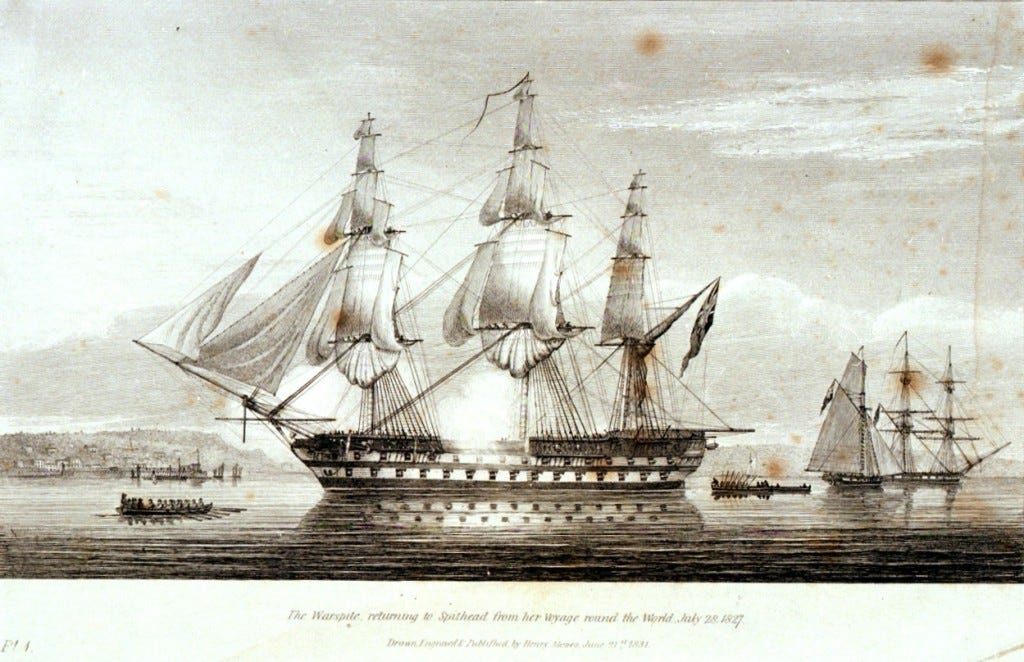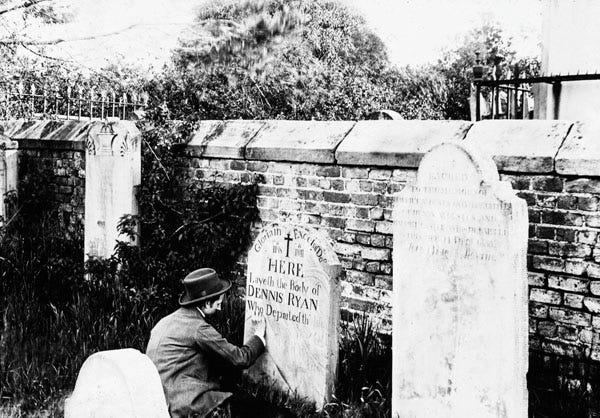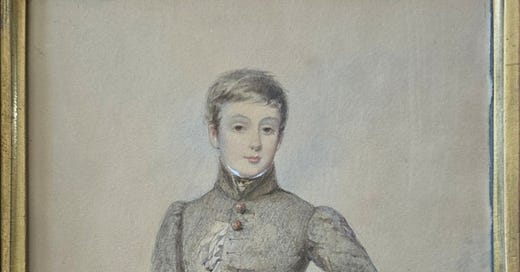My 3rd great grand uncle, Rowland Mainwaring (1811-1826) was the oldest son of Rowland Mainwaring, an officer in the Royal Navy, and his wife Sophia née Duff.
The younger Rowland Mainwaring was born on 11 September 1811 at Stoke, Devon. He travelled with his parents, first to Malta where he became sick. By 1813, the family had moved to Smyrna, in Turkey, where his sister was born. By 1815, when his younger brother Edward Pellew was born, the family had moved back to Malta.
On 30 September 1815 , the brig-sloop ‘Paulina‘, with Mainwaring aboard, was ordered to proceed to Plymouth, and Rowland Mainwaring returned to England with his “family, goods and chattels, a milch goat, and various little comforts and luxuries for the voyage home.” He was paid off in November 1815 and did not serve afloat again.
The family settled in Bath. In Mainwarings of Whitmore Gordon-Cavenagh-Mainwaring describes the life of Rowland senior:
After their return to England they took up their abode at Bath. He paid Window Tax on 21 windows in 1819. A Diary (1819-1862), now at Whitmore, gives a record of their daily life. Annual visits to Teignmouth in summer, and to Whitmore in the autumn, for the shooting, and occasional visits to various relations in other parts of the country. Rowland Mainwaring seems to have been singularly energetic, and his diary records that he received lessons in painting, drawing, fencing, playing the flute, and also French. Nearly every weekday, when at home, he was occupied in “ schooling ” his young children, and on Sundays he regularly heard them repeat the collects and catechism. He appears to have been a great walker. On one occasion he set out to walk from Gosport to Bath, reaching Southampton on the first day, a distance of 25 miles; on the following day his destination was Deptford Inn, about 10 miles beyond Salisbury on the road to Frome; on the third day he reached Beckington, about 4 miles beyond Frome, and then took the coach to Bath.In November 1824, at the age of 13, the younger Rowland Mainwaring entered the Royal Navy as a volunteer 1st class, and was posted a midshipman on HMS Warspite, a 74-gun third-rate ship of the line built in 1807.

In1826–27 Warspite sailed around the world. She visited Port Jackson (Sydney), the first ship of the line to visit the colony of New South Wales.
On Friday 20 October 1826, a Sydney newspaper called the Monitor announced the arrival of the HMS Warspite from Trincomalee, Ceylon:
SHIPPING INTELLIGENCE. ARRIVALS-...H. M. S. WARSPITE. 74 Guns and 500 Men, Commodore Sir James Brisbane. From Trincomalee August 26th.The Sydney Gazette of 21 October included a poem in honour of the Warspite, a description of her arrival (which mentioned the illness of the commodore Sir James Brisbane), and more details of the welcome.
Thursday last presented a novel and magnificent spectacle. About 10 o'clock the Warspite weighed anchor, and proceeded, under the auspices of fair wind and flood tide, to direct her course towards the capital of Australia. Long had the notion been idly indulged that a line-of-battle ship, of her magnitude, would be unable to pass the Sow-and- Pigs, but that prejudice, like hundreds of others, has successfully been confuted; and there can be little doubt but the largest ships in the Navy would, with the greatest facility imaginable, find their way to Sydney Cove, or to Darling Harbour. A little after 11, the massy floating pile rounded Bradley's Head, when the battery at Point Piper, as usual, anticipated the honours of the Fort, and royally saluted the Commodore. With a mild sea breeze, the Warspite came majestically along, and we never witnessed so grand a sight in the Colony. The town's people, high and low, rich and poor, flocked in hundreds to Dawe’s Battery, to catch a glimpse of the gratifying novelty. At noon, she came to an anchor; and, in the course of a few minutes, with music playing, fired the usual salute from her numberless port-holes, which made no trifling impression on the ear. The compliment, as directed by the Authorities, was immediately returned. In the course of an hour afterwards, Colonel DUMARESQ. Private Secretary His EXCELLENCY the GOVERNOR in CHIEF, paid an official visit on board to the Commodore, who was pleased to express himself much gratified with the attention manifested towards him, but delayed landing until yesterday. Sir JAMES is rather unwell, and has suffered, it is said, most severely from an indisposition peculiar to the destructive clime of India; but, should the Commodore only continue with us a few weeks, he will be certain to leave us with renovated heath, and his spirits will be exhilarated with the attention and respect which a BRISBANE will undoubtedly receive from all classes of the Community.Further information about the ship in harbour was in a report in The Australian of 25 October. A journalist from the Monitor went on board, and his report was published 27 October.
On 27 October 1826 Rowland Mainwaring, just 15 years old, died in Sydney of dysentery.
On 19 December 1826 Sir James Brisbane, commodore of the Warspiteat the time of Rowland’s death, also died in Sydney, the result of illness contracted on previous service in Burma. There is a memorial to Brisbane in St James’s Church, Sydney.
Rowland Mainwaring and James Brisbane were both buried in the Devonshire Street Cemetery at Brickfield Hill.
The funeral of a midshipman from the Warspite was reported in the Monitor of Friday 3 November 1826:
The funeral of the son of Admiral Sir John Borlase Warren, a midshipman on board H. M. S. Warspite, took place on Saturday last. The body was removed from the vessel at three o'clock in the jolly-boat. It was met at the dock-yard by a firing party and the band of the Buffs regiment, and moved along George-street, followed by the midshipmen of the ships of war now in harbour, and the boats-crew of the Warspite. The Union Jack supplied the place of a pall, which was borne by four friends of the deceased. He had long been an invalid, and departed this life on the preceding evening, to the great regret of his brother officers.I have not been able to find the burial of a man named Warren in 1826, and perhaps this report is in fact about the funeral of Rowland Mainwaring. Warren’ could be a mispronunciation of the second two syllables of ‘Mainwaring’. The previous Saturday was 28 October, which means that death occurred on the evening of 27 October, the day that Rowland died. In 1826 Rowland’s father held the rank of commander.
It was not until the following year that news of Rowland’s death reached England. The circumstances of his death on the Warspite was reported in various English newspapers including the London Packet and New Lloyd’s Evening Post 23 April 1827
Letters have been received from his Majesty's ship Warspite, dated the 4th of December, from Port Jackson (New South Wales); she had seven weeks' passage from Trincomalee, five of which Commodore Sir James Brisbane was confined to his bed. The ship arrived on the 19th October and he landed somewhat better; but a relapse of dysentery ensued, and we have much regret in adding, that on the 2d December he was so ill as to be despaired of; but when the letters came away a little change had ensued, which produced a hope. Lady Brisbane and family, in point of health, were well. Sir James Brisbane's attack commenced at Prome, six months before, and he was so reduced at Trincomalee, as to be with difficulty removed from the Boadicea to the Warspite. Mr. Rowland Mainwaring, midshipman (son of Captain Rowland Mainwaring), died on the 27th of October, of dysentery.The Devonshire Street cemetery
The Devonshire Street cemetery, where Roland Mainwaring was buried, was consecrated in 1820. By 1860, it was full. It was closed in 1888, with the last interment in 1891.
In 1901, the cemetery ground was resumed to allow for the development of the Central railway station. 30,000 bodies had to be removed. Remains that were claimed were transferred to a number of cemeteries throughout Sydney and even to Newcastle, over 160 kilometers north. Unclaimed remains were relocated to a purpose-built cemetery, Bunnerong Cemetery, which now forms part of the Eastern Suburbs Memorial Park in Matraville.
Before the graves were exhumed, a local couple named Arthur and Josephine Ethel Foster, documented the cemetery with photographs and copying the inscriptions into a notebook.


2825 tombstones were moved to Bunnerong. In 1976 the Botany Cemetery Trust removed most of these and created a new, low maintenance lawn area, with 746 headstones in concrete strips, unrelated to the graves below.
Rowland Mainwaring was reinterred at Bunnerong, but his headstone did not survive the 1976 beautification program by the Botany Cemetery Trust.
Brisbane was also interred at Devonshire Street but his remains were reinterred at Waverley Cemetery.
Related posts and further reading
Midshipman Rowland Mainwaring (the father of young Rowland)
Edmonds, E. (2019). Dead central. State Library of New South Wales. https://www.sl.nsw.gov.au/stories/dead-central
Foster, A. G. (1919). The sandhills: An historic cemetery. Project Gutenberg Australia. https://gutenberg.net.au/ebooks21/2100351h.html
FindAGrave memorials to Rowland Mainwaring and Sir James Brisbane.
Wikitree: Rowland Mainwaring (1811-1826)
This post first published at https://anneyoungau.wordpress.com/2025/04/21/r-is-for-rowland/


